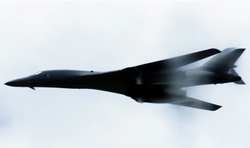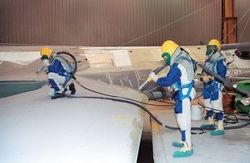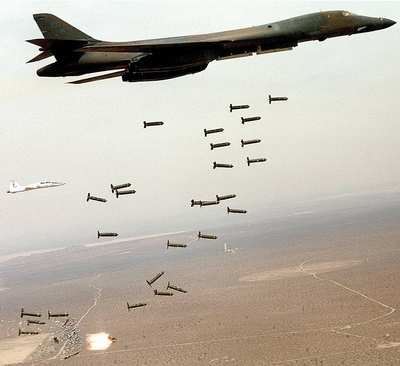B-1s Get Special Treatment
 Layer by layer, a B-1
Lancer at scenic Tinker AFB (OK) sheds paint under a pressurized
assault by tiny bits of plastic. It is the first aircraft at the
Oklahoma City Air Logistics Center to be stripped by the dry-media
process in the high-tech facility used to remove paint.
Layer by layer, a B-1
Lancer at scenic Tinker AFB (OK) sheds paint under a pressurized
assault by tiny bits of plastic. It is the first aircraft at the
Oklahoma City Air Logistics Center to be stripped by the dry-media
process in the high-tech facility used to remove paint.
The medium is a mix of plastics, each with different densities
and cutting qualities. The texture is like grains of sand,
according to Brian Koehl, a B-1 structural engineer.
The plastics are safe to use on both aluminum and composite
parts, which is important since the B-1’s 10,500 square feet
of surface [roughly 1/4 acre --ed.] area is 10 percent composite,
he said.
Previously, workers would "scuff sand" the bomber’s skin
to remove enough of the existing coating to create a surface to
which new paint could adhere. Throughout the course of depot
maintenance cycles, however, that became more difficult to do, he
said. "We had to find some way to get the paint off," he said.
The B-1 test subject was built in 1986 and underwent its first
depot maintenance in 1990. By 2003, its paint coatings were .015"
thick, five times the thickness of the Lancer’s original
paint job.
Nearly a Ton of Paint
 The aircraft was weighed
before and after the chemical stripping, Koehl said, showing it was
carrying 1,800 pounds of paint before the chemical strip. Such
weight, "potentially could reduce the (bomber’s) range or
increase fuel usage," he said.
The aircraft was weighed
before and after the chemical stripping, Koehl said, showing it was
carrying 1,800 pounds of paint before the chemical strip. Such
weight, "potentially could reduce the (bomber’s) range or
increase fuel usage," he said.
Two years ago, the logistics center workers chemically stripped
a B-1. Not only was the process time consuming -- three weeks to
mask the aircraft and two weeks to strip it -- but the chemicals
could not be used on the plane’s composite parts.
The time it took to mask and strip this B-1 was 18 days, but
workers have a goal of 12 days, according to David Painter, a
production supervisor.
The new process is a prototype for the B-1, Painter said. The
dry medium, he said, is performing up to expectations, although
there have been a few mechanical problems with equipment. "As far
as how (well) the blaster removes the paint, everything looks
great," Koehl said. "The B-1 program has been looking at processes
to remove paint since the early ’90s. Media blasting has been
around a number of years, but it just now got to the point (where)
it’s safe on composites."
The spent media is swept up and put into a recovery system,
where a series of shakers filter out dust and paint chips. It can
be cleaned and reused an estimated 10 times.
The process is preferred by most workers, he said, because there
is no chemical smell. "But this (process) is labor intensive,"
Painter said. Workers must hold a hose to spray the composite at 30
pounds per square inch for "four to five hours at a time."

Both the B-52 Stratofortress and KC-135 Stratotanker have been
approved for dry-media stripping. The B-1 was "kind of unique" in
that time constraints and the potential for damaging composite
parts made traditional chemical strippers unfeasible, Koehl
said.
The dry media is a "real good option to try to do away" with
pollution caused by chemical strippers, according to Painter.
Twelve B-1 aircraft come through the center each year for depot
maintenance, he said.
[Thanks to Jeanne Grimes, Oklahoma City Air Logistics Center
Public Affairs --ed.]
 ANN's Daily Aero-Term (04.25.24): Airport Rotating Beacon
ANN's Daily Aero-Term (04.25.24): Airport Rotating Beacon ANN's Daily Aero-Linx (04.25.24)
ANN's Daily Aero-Linx (04.25.24) Klyde Morris (04.22.24)
Klyde Morris (04.22.24) Airborne 04.24.24: INTEGRAL E, Elixir USA, M700 RVSM
Airborne 04.24.24: INTEGRAL E, Elixir USA, M700 RVSM Airborne 04.22.24: Rotor X Worsens, Airport Fees 4 FNB?, USMC Drone Pilot
Airborne 04.22.24: Rotor X Worsens, Airport Fees 4 FNB?, USMC Drone Pilot





